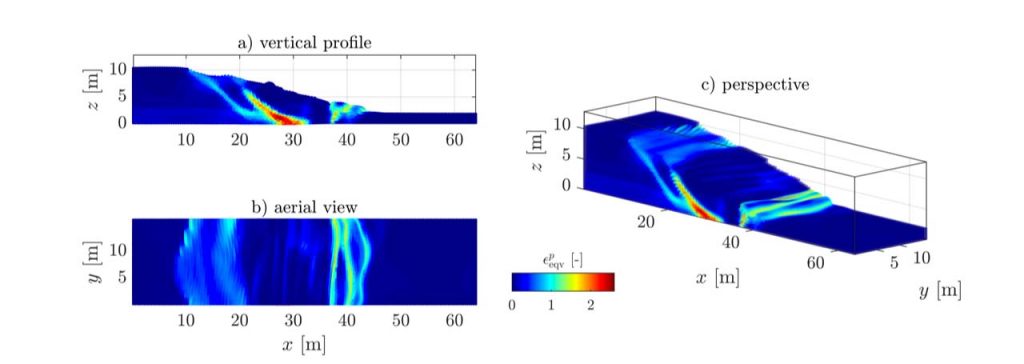Cette publication est également disponible en :
![]() Français
Français

Emmanuel Wyser, December 17th 2021, Institute of Earth Sciences (ISTE)
Plastic strain localization is an important process on Earth. It strongly influences the mechanical behaviour of natural processes, such as fault mechanics, earthquakes or orogeny. At a smaller scale, a landslide is a fantastic example of elasto-plastic deformations. Such behaviour spans from pre-failure mech-anisms to post-failure propagation of the unstable material. To fully resolve the landslide mechanics, the selected numerical methods should be able to efficiently address a wide range of deformation magnitudes.
Accurate and performant numerical modelling requires important compu-tational resources. Mesh-free numerical methods such as the material point method (MPM) or the smoothed-particle hydrodynamics (SPH) are particu-larly computationally expensive, when compared with mesh-based methods, such as the finite element method (FEM) or the finite difference method (FDM). Still, mesh-free methods are particularly well-suited to numerical problems involving large elasto-plastic deformations. But, the computational efficiency of these methods should be first improved in order to tackle complex three-dimensional problems, i.e., landslides.
As such, this research work attempts to alleviate the computational cost of the material point method by using the most recent graphics processing unit (GPU) architectures available. GPUs are many-core processors originally designed to refresh screen pixels (e.g., for computer games) independently. This allows GPUs to delivers a massive parallelism when compared to central processing units (CPUs).
To do so, this research work first investigates code prototyping in a high-level language, e.g., MATLAB. This allows to implement vectorized algorithms and benchmark numerical results of two-dimensional analysis with analytical solutions and/or experimental results in an affordable amount of time. After-wards, low-level language such as CUDA C is used to efficiently implement a GPU-based solver, i.e., ep2-3De v1.0, can resolve three-dimensional prob-lems in a decent amount of time. This part takes advantages of the massive parallelism of modern GPU architectures. In addition, a first attempt of GPU parallel computing, i.e., multi-GPU codes, is performed to increase even more the performance and to address the on-chip memory limitation. Finally, this GPU-based solver is used to investigate three-dimensional granular collapses and is compared with experimental evidences obtained in the laboratory.
This research work demonstrates that the material point method is well suited to resolve small to large elasto-plastic deformations. Moreover, the computational efficiency of the method can be dramatically increased using modern GPU architectures. These allow fast, performant and accurate three-dimensional modelling of landslides, provided that the on-chip memory limitation is alleviated with an appropriate parallel strategy.


